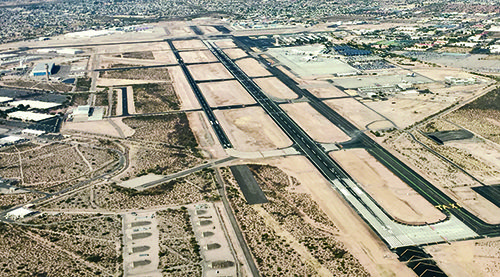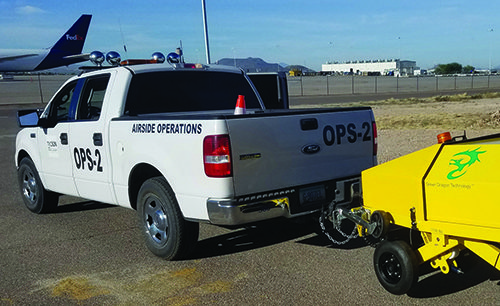When it comes to runway safety, Tucson International Airport (TUS) isn’t waiting for an accident or regulatory sanctions to make improvements. It’s acting proactively.
Last fall, the Arizona airport purchased its own continuous friction measuring equipment to enhance operational safety and boost the efficiency of its ongoing rubber removal efforts. If not removed, rubber residue left behind by aircraft tires during landing eventually will impede aircraft braking and control, with potentially catastrophic results.
“We can maintain our runway at a better value for a longer period of time, and more accurately evaluate runway safety conditions,” explains Marc Gomez, director of Airside Operations at TUS.
|
Program: Friction Testing/Rubber Removal Location: Tucson (AZ) Int’l Airport Purpose: Routine removal of rubber residue on runways to improve aircraft braking & control Friction Testing Equipment: 2018 NAC-Dynamic Friction Tester, from Neubert Aero Corp. Price: $58,000
Comparative Cost for Outside Testing: Rubber Removal: Cyclone Technology |
Because the FAA does not actively enforce friction testing rules, many airports do not adhere to the standards until there is an incident that forces the issue, says Tim Neubert, president of the International Friction Pavement Association and president of Neubert Aero Corp., which manufactured TUS’ equipment. TUS took the initiative to keep airport users safe on its own accord, he emphasizes.
“This is a federal requirement, but complying is up to you,” says Neubert. “Airports like Tucson International are in a leadership position using reliable and repeatable equipment to make good decisions when questions about airport runways should be open or closed.”
Regulations are in place to make sure runways are safe for pilots and passengers, but there are no penalties for failing to comply with the regulations, he adds.
By Neubert’s estimation, there are less than 100 pieces of continuous friction measuring equipment at all 2,800 commercial service airports in the United States.
In-house Testing
Previously, TUS cleared its runways of rubber residue three to four times a year based solely on visual inspections and a general sense that it was time for upkeep. “We really could have applied this benefit a couple years ago, but it works out good now,” says Gomez.
The friction tester purchased last fall allows TUS to evaluate the status of runways objectively and eliminates guesswork regarding safety limits, explains Neubert. The unit measures traction on runways and the operator then sends data to the control tower, which then relays it to pilots before they make their final approaches. The data also tells maintenance crews when it is time to remove rubber residue. Frequency for friction testing is based on the average mix of turbojet aircraft operating on a particular runway, as outlined in FAA AC 150/5320-12C – Measurement, Construction, and Maintenance of Skid Resistant Airport Pavement Surfaces. Testing is also required immediately after rubber removal to evaluate whether friction values have increased accordingly.
“In theory, if a runway is contaminated due to weather or rubber buildup, the airport performs a friction survey and sends data to pilots, who make an assessment about how much braking to apply or how to adjust the aircraft,” says Neubert. “Planes are typically configured to land on dry surfaces, so landing on a wet surface can create a hydroplaning effect, and the tires will lock. This data will help them adjust how much skid resistance to apply on jet braking systems when landing.”
Many airports rely on their rubber removal contractors for friction testing—a practice Neubert and others advise against due to the potential for a conflict of interest. Having the same company test whether its removal services are needed could raise questions about the objectivity of its test results, he explains.
For Neubert, it all comes down to airfield safety. “The No. 1 reason we perform friction testing is to prevent aircraft accidents,” he stresses. “That’s why it’s important to have this or another certified unit at every commercial service airport.”
Equipment Details
 TUS purchased a standard tow-behind NAC-Dynamic Friction Tester in November 2017 for $58,000. Company personnel note that it is one of only a handful of friction testing units certified by the FAA for airport use. Choosing a tow-behind unit rather than a dedicated testing vehicle boosts operational flexibility, because vehicle components are more likely to need service than the actual testing equipment, says Neubert.
TUS purchased a standard tow-behind NAC-Dynamic Friction Tester in November 2017 for $58,000. Company personnel note that it is one of only a handful of friction testing units certified by the FAA for airport use. Choosing a tow-behind unit rather than a dedicated testing vehicle boosts operational flexibility, because vehicle components are more likely to need service than the actual testing equipment, says Neubert.
Now that TUS owns its own friction testing equipment, there is no need to outsource the job to a contractor. At an average cost of $1,800 per runway, that would have amounted to $5,400 to $7,200 per year, reports Neubert. He also estimates the airport has saved hundreds of thousands of dollars in planned but unneeded rubber removal.
Staff members at TUS received two days of training with their new equipment—one day of classroom presentations about friction testing and another day of hands-on sessions to learn about the unit’s specific features. “You need qualified operators trained by the manufacturer for generating and disseminating results to pilots,” says Neubert.
Gomez and his crew took delivery of the new testing equipment just as the airport was reopening its main runway after a six-week closure for resurfacing. The recent runway improvements gave officials another reason to invest in equipment to maximize the lifecycle of a key airfield asset, says Gomez.
 “Since it’s a brand-new runway, there wasn’t much to do maintenance-wise,” he relates. “But it is interesting to see the results after a friction survey—to see where the aircraft touchdowns are and see it on the graphs after that, knowing what gets hit the most. This helps us with scheduling painting.”
“Since it’s a brand-new runway, there wasn’t much to do maintenance-wise,” he relates. “But it is interesting to see the results after a friction survey—to see where the aircraft touchdowns are and see it on the graphs after that, knowing what gets hit the most. This helps us with scheduling painting.”
For more information about continuous friction measuring equipment, our Industry Insider column from John O’Callaghan of the National Safety Transportation Board.



 facts&figures
facts&figures

